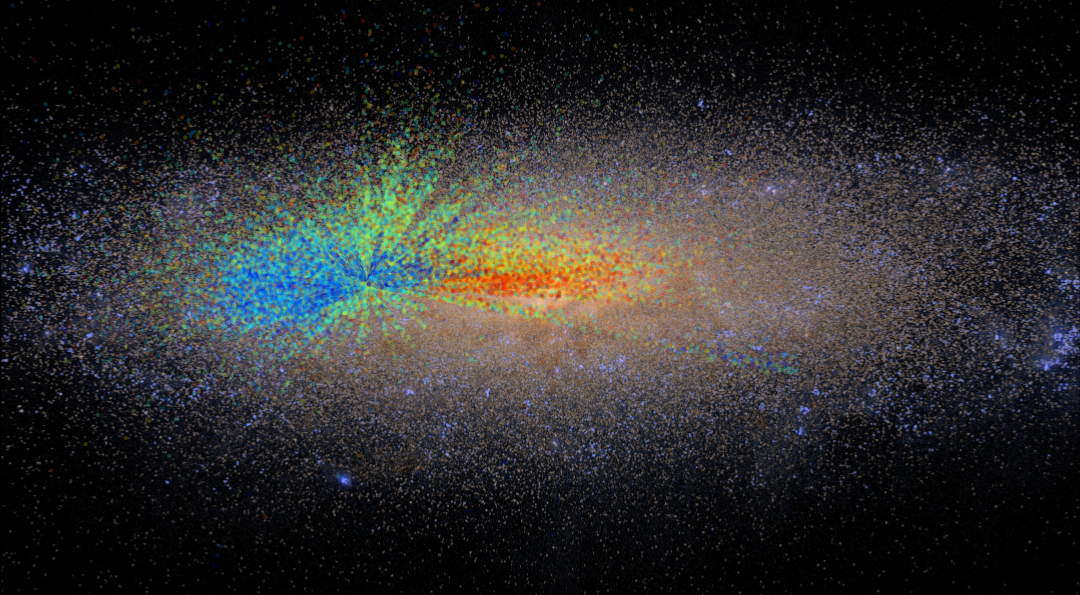Proud parents chart the growth of their children, but astronomers from the Sloan Digital Sky Survey (SDSS) have taken on a bigger task: charting the growth of our own Milky Way.
In a result presented today at the American Astronomical Society meeting in Kissimmee, Florida, a team led by Melissa Ness of the Max Planck Institute for Astronomy in Heidelberg, Germany created the first-ever “growth chart” for our Milky Way Galaxy. Their chart, which uses the ages of more than 70,000 stars and extends halfway across our Galaxy to 50,000 light-years away, helps us read the story of how our Galaxy grew from its infancy to the bright spiral galaxy we see today.
Credit: G. Stinson (MPIA)
Melissa Ness
“Our Galaxy grew up by growing out.”
“Close to the center of our Galaxy, we see old stars that were formed when it was young and small. Farther out, we see young stars. We conclude that our Galaxy grew up by growing out,” says Ness, lead author of the study. “To see this, we needed an age map spanning large distances, and that’s what this new discovery gives us.”
The researchers mapped the Galaxy by observing red giants, bright stars in the final stages of their lives that can be observed out to large distances from our Sun, into the very inner and outer reaches of the Milky Way. “If we know the mass of a red giant star, we know its age by using the fusion clock inside every star,” says Marie Martig, lead author of a related study and a co-author of Ness’s study. “Finding masses of red giant stars has historically been very difficult, but surveys of the Galaxy have made new, revolutionary techniques possible.”
Steve Majewski
The team started with spectra taken from one of the SDSS’s component surveys, the Apache Point Observatory Galaxy Evolution Experiment (APOGEE). “APOGEE is the ideal survey for this work because it can get high-quality spectra for 300 stars simultaneously over a large area of sky,” says Steve Majewski of the University of Virginia and Principal Investigator of the APOGEE survey. “Seeing so many stars at once means getting spectra of 70,000 red giants is actually possible with a single telescope in a few years’ time.”
The ages of stars cannot be measured with APOGEE spectra alone, but the APOGEE team realized that light curves from the Kepler satellite, a NASA space mission whose main goal is to find planets around stars, could provide the missing link between APOGEE spectra and stellar ages. APOGEE therefore observed thousands of red giants that had also been seen by Kepler. After combining information from the APOGEE spectra and Kepler lightcurves, the researchers could then apply their methods to measure ages for all 70,000 red giant stars sampling all parts of the galaxy.
“In the galaxy we know best – our own – we can clearly read the story of how galaxies form in a Universe with large amounts of cold dark matter,” says Ness. “Because we can see so many individual stars in the Milky Way, we can chart its growth in unprecedented detail. This unprecedented, enormous map really is one for the ages.”
Contacts
- Melissa Ness, Max-Planck-Institut fur Astronomie, ness@mpia-hd.mpg.de, 49-6221-528-412
- Marie Martig, Max-Planck-Institut fur Astronomie, martig@mpia.de, 49-6221-528-455
- Steve Majewski, University of Virginia, srm4n@virginia.edu, 434-924-4893
External Press Release
- Institution
- Max-Planck-Institute for Astronomy
- Release
- Making (galactic) history with big data: First global age map of the Milky Way




